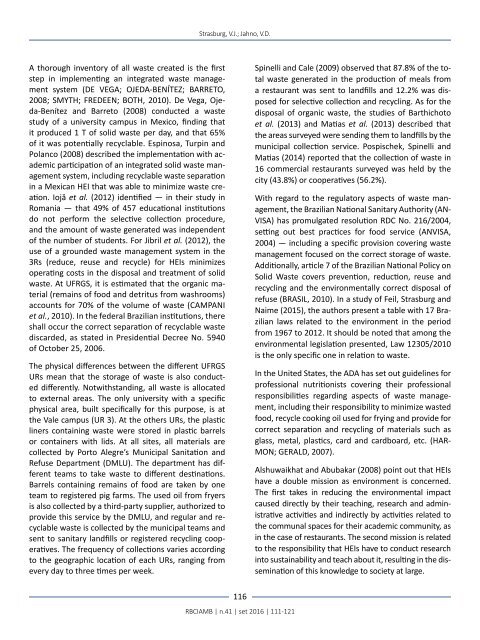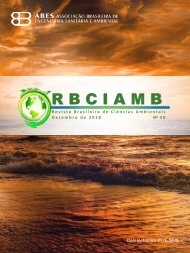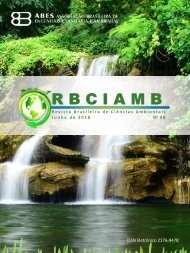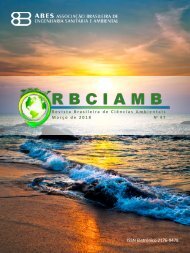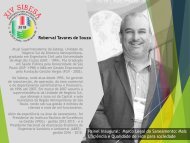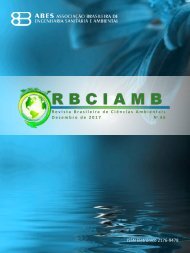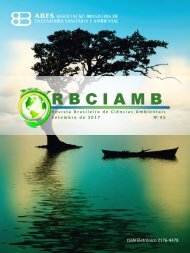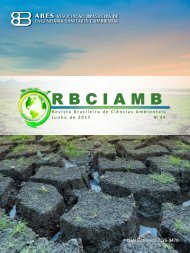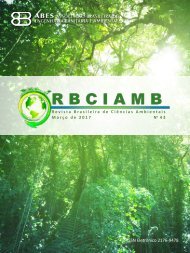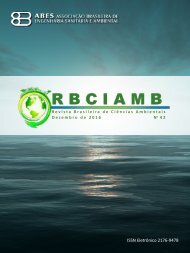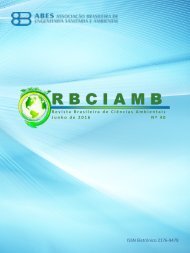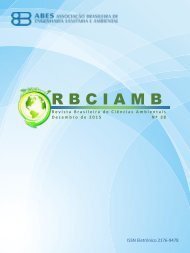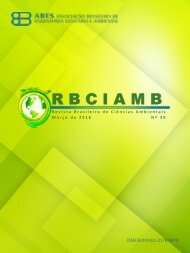EDIÇÃO 41 RBCIAMB
Create successful ePaper yourself
Turn your PDF publications into a flip-book with our unique Google optimized e-Paper software.
Strasburg, V.J.; Jahno, V.D.<br />
A thorough inventory of all waste created is the first<br />
step in implementing an integrated waste management<br />
system (DE VEGA; OJEDA-BENÍTEZ; BARRETO,<br />
2008; SMYTH; FREDEEN; BOTH, 2010). De Vega, Ojeda-Benítez<br />
and Barreto (2008) conducted a waste<br />
study of a university campus in Mexico, finding that<br />
it produced 1 T of solid waste per day, and that 65%<br />
of it was potentially recyclable. Espinosa, Turpin and<br />
Polanco (2008) described the implementation with academic<br />
participation of an integrated solid waste management<br />
system, including recyclable waste separation<br />
in a Mexican HEI that was able to minimize waste creation.<br />
Iojă et al. (2012) identified — in their study in<br />
Romania — that 49% of 457 educational institutions<br />
do not perform the selective collection procedure,<br />
and the amount of waste generated was independent<br />
of the number of students. For Jibril et al. (2012), the<br />
use of a grounded waste management system in the<br />
3Rs (reduce, reuse and recycle) for HEIs minimizes<br />
operating costs in the disposal and treatment of solid<br />
waste. At UFRGS, it is estimated that the organic material<br />
(remains of food and detritus from washrooms)<br />
accounts for 70% of the volume of waste (CAMPANI<br />
et al., 2010). In the federal Brazilian institutions, there<br />
shall occur the correct separation of recyclable waste<br />
discarded, as stated in Presidential Decree No. 5940<br />
of October 25, 2006.<br />
The physical differences between the different UFRGS<br />
URs mean that the storage of waste is also conducted<br />
differently. Notwithstanding, all waste is allocated<br />
to external areas. The only university with a specific<br />
physical area, built specifically for this purpose, is at<br />
the Vale campus (UR 3). At the others URs, the plastic<br />
liners containing waste were stored in plastic barrels<br />
or containers with lids. At all sites, all materials are<br />
collected by Porto Alegre’s Municipal Sanitation and<br />
Refuse Department (DMLU). The department has different<br />
teams to take waste to different destinations.<br />
Barrels containing remains of food are taken by one<br />
team to registered pig farms. The used oil from fryers<br />
is also collected by a third-party supplier, authorized to<br />
provide this service by the DMLU, and regular and recyclable<br />
waste is collected by the municipal teams and<br />
sent to sanitary landfills or registered recycling cooperatives.<br />
The frequency of collections varies according<br />
to the geographic location of each URs, ranging from<br />
every day to three times per week.<br />
Spinelli and Cale (2009) observed that 87.8% of the total<br />
waste generated in the production of meals from<br />
a restaurant was sent to landfills and 12.2% was disposed<br />
for selective collection and recycling. As for the<br />
disposal of organic waste, the studies of Barthichoto<br />
et al. (2013) and Matias et al. (2013) described that<br />
the areas surveyed were sending them to landfills by the<br />
municipal collection service. Pospischek, Spinelli and<br />
Matias (2014) reported that the collection of waste in<br />
16 commercial restaurants surveyed was held by the<br />
city (43.8%) or cooperatives (56.2%).<br />
With regard to the regulatory aspects of waste management,<br />
the Brazilian National Sanitary Authority (AN-<br />
VISA) has promulgated resolution RDC No. 216/2004,<br />
setting out best practices for food service (ANVISA,<br />
2004) — including a specific provision covering waste<br />
management focused on the correct storage of waste.<br />
Additionally, article 7 of the Brazilian National Policy on<br />
Solid Waste covers prevention, reduction, reuse and<br />
recycling and the environmentally correct disposal of<br />
refuse (BRASIL, 2010). In a study of Feil, Strasburg and<br />
Naime (2015), the authors present a table with 17 Brazilian<br />
laws related to the environment in the period<br />
from 1967 to 2012. It should be noted that among the<br />
environmental legislation presented, Law 12305/2010<br />
is the only specific one in relation to waste.<br />
In the United States, the ADA has set out guidelines for<br />
professional nutritionists covering their professional<br />
responsibilities regarding aspects of waste management,<br />
including their responsibility to minimize wasted<br />
food, recycle cooking oil used for frying and provide for<br />
correct separation and recycling of materials such as<br />
glass, metal, plastics, card and cardboard, etc. (HAR-<br />
MON; GERALD, 2007).<br />
Alshuwaikhat and Abubakar (2008) point out that HEIs<br />
have a double mission as environment is concerned.<br />
The first takes in reducing the environmental impact<br />
caused directly by their teaching, research and administrative<br />
activities and indirectly by activities related to<br />
the communal spaces for their academic community, as<br />
in the case of restaurants. The second mission is related<br />
to the responsibility that HEIs have to conduct research<br />
into sustainability and teach about it, resulting in the dissemination<br />
of this knowledge to society at large.<br />
116<br />
<strong>RBCIAMB</strong> | n.<strong>41</strong> | set 2016 | 111-121


